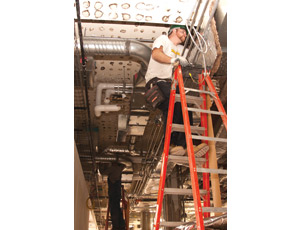Paul VanDuyne, president of Rock Island, Ill.-based KJWW Engineering Consultants, believes consulting engineers should neither be seen nor heard.

“If we’ve done our job, nobody knows about us,” he says. “If the building stands up, if it’s attractive and comfortable and everything is performing as it should, you’re not going to be thinking about the engineering.”
KJWW has given its peers plenty to think about by amassing a portfolio of surpassing invention, ranging from the largest lake-coupled geothermal system in the world, for which one of its employees received a 2009 ENR Newsmaker award, to fully integrated hybrid natural ventilation for a Midwest architectural school and its library. In 2010, no fewer than five of KJWW projects were named Best of the Midwest by Midwest Construction magazine, now ENR Midwest.
The full-service firm currently is at work on a new $115-million federal courthouse in Cedar Rapids, Iowa, that will consume no more than 55 kBtu of energy per sq ft per year, and an $80-million restoration of the University of Illinois’ Lincoln Hall, a century-old landmark in Champaign seeking LEED Gold certification.
Looming large at Lincoln Hall is its historic brick facade and, even larger, the 20 intake and exhaust louvers the building’s upgraded mechanical system requires. “What are the options?” asks Ron Harrison, project architect with architect/engineer Cannon Design, Chicago. “Eliminate windows? Alter the historic fabric?”
Instead, KJWW proposed deepening Lincoln’s basement, locating the louvers in the basement’s walls, constructing adjacent area wells and routing fresh and exhaust air via ductwork to new air-handling units residing in the corners of each of Lincoln’s four floors.
In addition to accommodating smaller ductwork, thereby permitting the addition of sprinklers, cable trays and the like, the dedicated air-handling units reduce fan power, says Paul Parry, principal at KJWW, who oversees the firm’s educational projects.
The firm’s environmentally minded designs have been good for its bottom line, too. In recent years, a steady steam of government, health-care and education projects has prompted the engineer to open additional regional offices, as well as outposts in India and United Arab Emirates. In the past decade, staff size has more than doubled to 400 from 176. Today, KJWW takes in about $50 million in revenue per year on projects valued at nearly $3 billion.
Mindful of the need to manage growth, KJWW recently purchased iPads for all employees. “We told them, ‘Sure, go ahead and use them for personal reasons, but accustom yourselves to using them for business,’” says VanDuyne.
Despite the expanding digital landscape, KJWW remains rooted in fairly simple principles. “We’ve always designed systems that are energy efficient and easy to maintain,” says VanDuyne. “From our early days we placed a great deal of emphasis on technical competence and innovation.”
In 2000, he recalls, KJWW designed a lake-coupled geothermal system for a hospital in Iowa “when engineers didn’t design hospitals that way because of air-transfer issues. But the solution yielded 30 percent energy savings.”
Other clients eventually took notice, but not before the firm fielded numerous requests for so-called LEED-lites. “They’d ask if we could give them something ‘kind of like LEED,’” VanDuyne says. “We went through a period of kind-of-like-LEED projects.”
Clients today—particularly those in higher education—recognize the value of sustainable design, despite the higher initial investment it frequently requires. “Their market is young people,” says Parry, “and young people are very attuned to environmental issues.”
LEED Platinum
In 2010, the company’s work on the University of Illinois Business Instructional Building, a facility requiring only half the energy of comparable buildings, earned KJWW the American Council of Engineering Companies of Illinois Eminent Conceptor Award, the most prestigious honor of its kind in the state and one more typically reserved for complex civil work.
By all accounts, including that of New Haven, Conn.-based project architect Pelli Clarke Pelli Architects, extensive collaboration in the project’s early conceptual phase allowed architect and consultants to integrate highly efficient systems into the $62-million, 160,000-sq-ft facility, including displacement ventilation, triple-glazed windows, CFC-free refrigerants and a 4,000-sq-ft photovoltaic array located atop the roof.
The facility is one of just a handful in Illinois to achieve LEED Platinum status.
Parry isn’t surprised. “You can’t achieve LEED Platinum if you’re handed a completed set of architectural plans and told, ‘Here, go ahead and drop in the mechanical and electrical and plumbing systems,’” he says. “That kind of reactive engineering may yield LEED Silver, but we tend to aim higher, which is why we insist on early involvement in high-performance projects. The engineering has to be integrated. With the Business Building, we were involved in sun-angle analysis, building orientation, envelope design—a number of conceptual studies.”
“When an environmental consultant the university hired suggested low-velocity displacement, Paul [Parry] didn’t bat an eye,” recalls Craig Copeland, senior associate at Pelli Clarke Pelli and design team leader on the project. “He immediately grasped the potential for superior air quality and incredible energy efficiency.”


Post a comment to this article
Report Abusive Comment